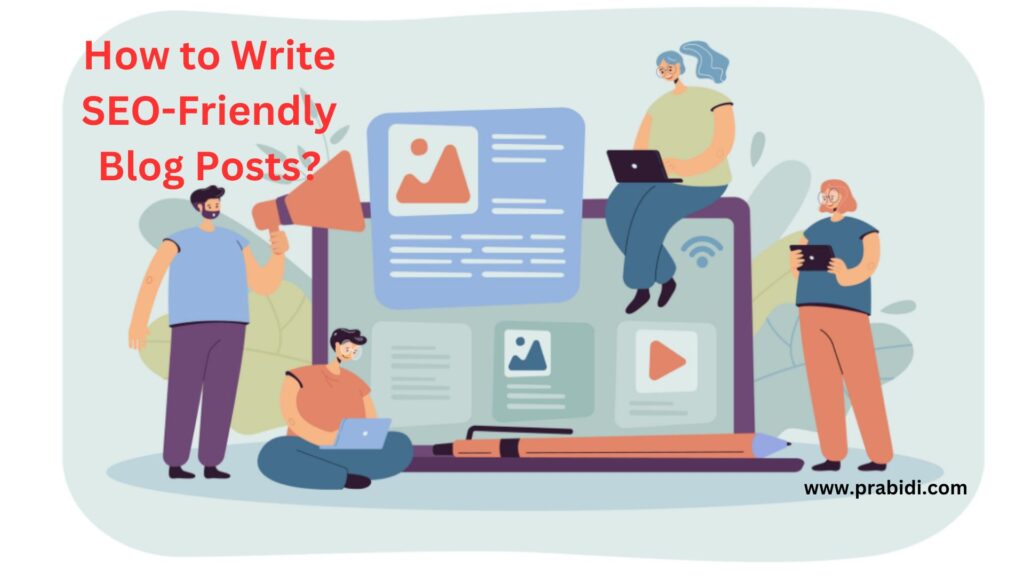Do you wonder how to write SEO- Friendly blog posts? Want to create content that ranks on top? Despite your experience level creating high-quality content is a difficult job. Here we will discover 15 tried-and-true guidelines for creating thoroughly detailed articles on how to write SEO-friendly blog posts that will make Google swoon!
Introduction
Writing blog posts that are search engine friendly is quite a challenging and difficult task. The phrase “content is king” is certainly said more times than you can count if you’re a blogger or content provider. So let’s get started with an article that is fully discussed on “How to Write SEO-Friendly Blog Posts: Top 15 Tips to Rank on Top.” We’ll discuss everything, from keyword analysis to engaging headlines. The ride is going to be crazy so buckle up!
Are you prepared to promote your blog posts the way they need to be promoted? For the finest advice on how to go up the search engine results pages, keep reading!

1. Keyword Research: Finding the Perfect Match
Knowing which keywords to target is necessary before you create entirely outlined articles on SEO-friendly blog posts. This involves finding and concentrating on particular words or phrases that users are likely to type into search engines. Your blog article is more likely to rank better in search results if you optimize your content for these keywords. Here are a few effective tips:
- Utilize keyword discovery tools like Ahrefs or Google’s Keyword Planner.
- Go for long-tail keywords to avoid as much competition.
- Look at the top-performing keywords of your competitors.
2. Create Interesting Headlines
Readers and search engines will view your headline first. Make it count! Your headline should be fascinating, accurately summarize the article’s content, and contain your main keyword. This increases click-through rates by making it easier for users and search engines to grasp the subject of your post.
- Keep it to 60 characters or less.
- Use your main keyword close to the start.
- For added impact, use numbers, emotive language, or questions.
3. Write a Killer Introduction
For readers to be engaged an interesting introduction is essential. Your introduction should be engaging, speak directly to your target audience, and promptly describe the subject. To help the search engines in determining the purpose of your material, it should also contain your main keyword. This is how to make it sparkle:
- Write to your audience directly.
- Introduce your subject briefly, mentioning any problems you plan to address.
- Add a few hints of your main term.
4. Organize Your Content with Subheadings
Your material is divided into smaller, easier-to-read pieces with the use of subheadings. To increase readability and SEO, they should be descriptive, contain keywords, and be formatted consistently. Utilize subheadings to divide your text into manageable portions that:
- Your primary and secondary keywords should be included.
- Clearly state the purpose of each part.
- Make sure the contents are consistently formatted.
5. Optimize Your Content’s Length
There is no fixed limit when it comes to content length. But longer content typically scores higher in search results. Because longer articles offer more detailed information, they typically rank higher on search engines. Try to make your blog post detailed and thoroughly researched which includes tiny details. In order to increase your chances of coming out on top, aim for at least 1,500 words.

6. Use Bullet Points and Numbered Lists
The user experience and SEO can both be enhanced by using these formatting options, which make your text easier to scan and read. Lists with numbers and bullet points work well for:
- Dividing lengthy paragraphs.
- Highlighting crucial details.
- Enhancing user experience and readability.
7. Add Internal and External Links
You can improve the authority and search engine rankings of your content by including links to other pages on your website and reliable outside sources. Use relevant keywords in your descriptive anchor text. SEO requires links to be effective. Consider the following advice:
- 1-2 internal links to pertinent pages on your website.
- To reliable sites, include outside links.
- Along with keywords, use evocative anchor text.
Read More: Mastering Keyword Research: The Key to SEO Success
8. Don’t Overdo Keyword Stuffing
Although applying keywords is crucial, be careful not to overuse them. Although incorporating keywords is crucial, overusing them might hurt your SEO and make your material appear forced. Use synonyms or related terms for variety and keep your keyword density between 1 and 2 %.
- Aim for 1-2% keyword density.
- Utilize LSI keywords and synonyms.
- Prioritize readability while writing naturally.
9. Include Relevant Images and Alt Text
Images can enhance the user experience and provide search engines with more context. Make sure they are of great quality, compressed for quick loading, and have keyword-rich alt text which is descriptive. Images boost SEO and the user experience. Be sure to:
- Use relevant, high-quality photos.
- Images should be compressed for quicker loading.
- Add keyword-rich alt text that is descriptive.
10. Optimize Your URL Structure
A short URL that avoids dates or special characters and uses hyphens rather than underscores also includes your main keyword. This makes it simpler for readers and search engines to figure out the subject of your material. Keep your URLs brief, sweet, and full of keywords:
- Instead of using underscores, use hyphens.
- Specify your main keyword.
- Use minimum keep dates and special characters.

11. Make Your Content Shareable
The reach of your content can be expanded, and increase search engine rankings by including social sharing buttons, producing shareable snippets, and encouraging readers to do so. Making it simple to share will expand the audience for your content:
- To your blog posts, add social sharing buttons.
- Create shareable, catchy snippets for social media.
- A call-to-action should be used to encourage readers to share your material.
12. Engage Your Readers with a Conversational Tone
You can make your blog post more relatable and engaging by writing in a conversational style. You can ask several interesting questions while writing which keeps audiences engaged with the post. You can contractions, phrases, slang, and other kinds of language to make engaging writing. Use a conversational tone when creating a fully descriptive article on “How to Write SEO-Friendly Blog Posts: Top 15 Tips to Rank on Top” to engage your audience:
- Use slang, idioms, and contractions.
- Interjections and transitional phrases should be used.
- Avoid using familiar phrases and poor sentence constructions.
13. Edit and Proofread for Perfection
Your credibility and search engine rankings will increase if your material is well-structured and error-free. To find any errors, use editing software, have someone else go over your work, or proofread several times. Grammar and spelling mistakes might undermine your SEO efforts. Ensure you:
- Edit your writing to make it more concise and clear.
- You can use a program like Grammarly or proofread your writing several times.
- Think about asking a friend or coworker to look through your writing.
14. Monitor and Update Your Content Regularly
Maintaining your content’s relevancy and enhancing its search engine rankings can be achieved by routinely evaluating its performance and updating it as necessary. Continually update your content to stay on top of the competition:
- Analyze the effectiveness of your content using tools like Google Analytics.
- Refresh out-of-date data and broken links.
- Improve the rating of underperforming content by optimizing it.
15. Promote Your Content
You can use email marketing, network with influencers, and share it on social media to raise the visibility of your content and improve website traffic. It’s time to promote your SEO-friendly blog content after it has been published.
- Publish your material on social media.
- Utilize email marketing to connect with your followers.
- Make connections with bloggers and industry influencers.
Read More: Make Money with Blogger in Just 12 Minutes
Conclusion
It may seem difficult to write an SEO-friendly blog post, but with these top 15 suggestions, you’ll be well on your way to moving up the search engine results pages. Always do your keyword research, write intriguing headlines, and make sure your content is optimized for both users and search engines. Keep your writing engaging and conversational, and after your material is released, don’t forget to promote it. Good luck with your writing, and here’s to rank first with your well-written article on “How to Write SEO-Friendly Blog Posts: Top 15 Tips to Rank on Top!”
FAQs
How many times should I use my main keyword in an article?
Aim for a keyword density of 1–2%. Additionally, make use of LSI keywords and synonyms word for maintaining the density of the Key.
How long a blog post should be to be SEO-friendly?
Longer articles get preference by search engine algorithms. For a full description, aim for a minimum of 1,500 words in your article on “How to Write SEO-Friendly Blog Posts: Top 15 Tips to Rank on Top.”
What’s the most efficient way to organize my content?
Use headings, numbered lists, and bullet points to break up your material and make it easier to read.
